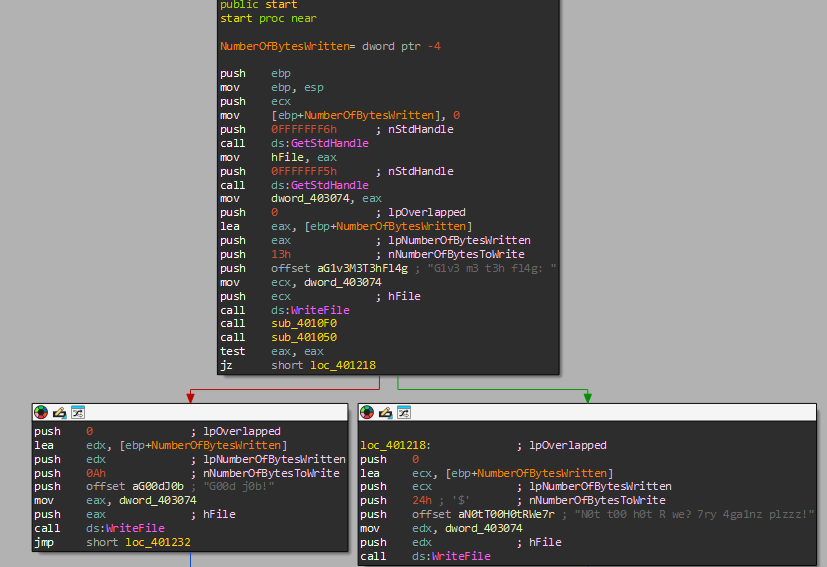Challenge 2
Challenge file given was exe executable, run with DIE will show this:

Running it with command prompt, will ask for user input:

We have to disassemble and reverse function that validate the string input
Solution:
1. Use IDA to decompile the executable to examine functions

Before the JZ instruction there are two function and within the start function there is no ReadFile function declare. So, we have to examine sub_4010F0 and sub_401050.
Here is the decompiled function of sub_4010F0:
int sub_4010F0()
{
unsigned int v0; // eax
char Buffer[260]; // [esp+0h] [ebp-110h] BYREF
DWORD NumberOfBytesRead; // [esp+104h] [ebp-Ch] BYREF
unsigned int i; // [esp+108h] [ebp-8h]
char v5; // [esp+10Fh] [ebp-1h]
v5 = 0;
for ( i = 0; i < 0x104; ++i )
Buffer[i] = 0;
ReadFile(hFile, Buffer, 0x104u, &NumberOfBytesRead, 0);
for ( i = 0; ; ++i )
{
v0 = sub_401020(Buffer);
if ( i >= v0 )
break;
v5 = Buffer[i];
if ( v5 != 10 && v5 != 13 )
{
if ( v5 )
byte_403078[i] = v5;
}
}
return 1;
}
Here it uses ReadFile function and filter the user input to ignore newline (\n = 10) and carriage return (\r = 13) are ignored. Also use byte_403078 to store the input.
Take a look at the next function sub_401050:
int sub_401050()
{
int v1; // [esp+0h] [ebp-Ch]
int i; // [esp+4h] [ebp-8h]
unsigned int j; // [esp+4h] [ebp-8h]
char v4; // [esp+Bh] [ebp-1h]
v1 = sub_401020((int)byte_403078);
v4 = sub_401000();
for ( i = v1 - 1; i >= 0; --i )
{
byte_403180[i] = v4 ^ byte_403078[i];
v4 = byte_403078[i];
}
for ( j = 0; j < 0x27; ++j )
{
if ( byte_403180[j] != (unsigned __int8)byte_403000[j] )
return 0;
}
return 1;
}
This function uses the byte_403078 perform rolling XOR since each bytes depends on the previous one. Then the result will compared to byte_403000. Next, with performing the same XOR operation against byte_403000 will give us the correct input string value. For the v4, which is derived from sub_401000 is a bitwise rotation left. The value return from sub_401000 is 0x0004.
2. Use x32dbg to extract the encrypted byte_403000
From the .data section of the executable, the first 39 bytes is the XOR encrypted string, perform a reverse XOR. Here is the script to reverse the operation:
package main
import "fmt"
func main() {
// Given byte_403000 array
byte403000 := []byte{
0x0D, 0x26, 0x49, 0x45, 0x2A, 0x17, 0x78, 0x44, 0x2B, 0x6C,
0x5D, 0x5E, 0x45, 0x12, 0x2F, 0x17, 0x2B, 0x44, 0x6F, 0x6E,
0x56, 0x09, 0x5F, 0x45, 0x47, 0x73, 0x26, 0x0A, 0x0D, 0x13,
0x17, 0x48, 0x42, 0x01, 0x40, 0x4D, 0x0C, 0x02, 0x69,
}
// Initial key (v4)
v4 := byte(0x04)
// Reconstruct byte_403078
byte403078 := make([]byte, len(byte403000))
for i := len(byte403000) - 1; i >= 0; i-- {
// Reverse the transformation: byte_403078[i] = byte_403000[i] ^ v4
byte403078[i] = byte403000[i] ^ v4
// Update v4 for the next iteration
v4 = byte403078[i]
}
// Print the reconstructed byte_403078 as a string
fmt.Printf("Reconstructed byte_403078 as string: %s\n", byte403078)
fmt.Printf("Reconstructed byte_403078 as hex: % X\n", byte403078)
}
Flag: R_y0u_H0t_3n0ugH_t0_1gn1t3@flare-on.com
